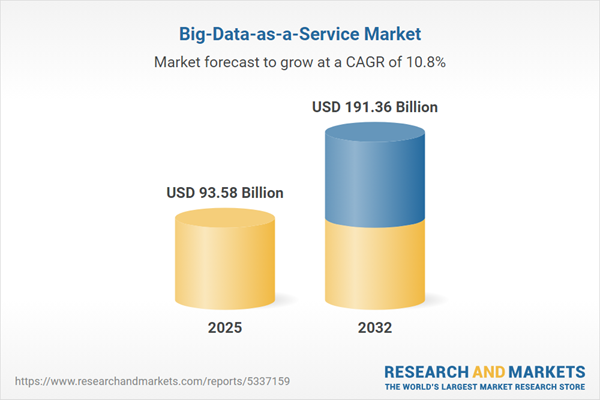Speak directly to the analyst to clarify any post sales queries you may have.
Big Data as a Service is now central to digital transformation strategies, allowing enterprises to unlock actionable intelligence and drive competitive advantage by leveraging advanced analytics in the cloud.
Market Snapshot: Big Data as a Service Market Growth and Outlook
The Big Data as a Service market grew from USD 84.47 billion in 2024 to USD 93.58 billion in 2025. It is anticipated to sustain a robust compound annual growth rate (CAGR) of 10.76%, ultimately reaching USD 191.36 billion by 2032. This expansion is propelled by the ongoing evolution of cloud infrastructure, the proliferation of IoT devices, and rising adoption of artificial intelligence and machine learning in enterprise data strategies. Businesses increasingly depend on real-time, scalable analytics to respond efficiently to shifting market forces and regulatory requirements.
Scope & Segmentation: In-Depth Coverage Across Service Types, Deployments, and Regions
This research report delivers a comprehensive view of the Big Data as a Service landscape, analyzing adoption patterns, technology use, and regional dynamics across the following areas:
- Service Type: Infrastructure as a Service, Platform as a Service, Software as a Service
- Deployment Model: Hybrid Cloud, Private Cloud, Public Cloud
- Organization Size: Large Enterprises, Small and Medium Enterprises
- Industry Vertical: Banking, Corporate Banking, Retail Banking, Capital Markets, Insurance, Government and Public Sector, Defense, Education, Healthcare, Hospitals and Clinics, Pharmaceutical Research, IT Services, Telecom Service Providers, Manufacturing, Automotive, Electronics, Industrial Machinery, Media and Entertainment, Broadcasting, Gaming, Publishing, Retail, Brick and Mortar, E-Commerce
- Americas: United States, Canada, Mexico, Brazil, Argentina, Chile, Colombia, Peru
- Europe, Middle East & Africa: United Kingdom, Germany, France, Russia, Italy, Spain, Netherlands, Sweden, Poland, Switzerland, United Arab Emirates, Saudi Arabia, Qatar, Turkey, Israel, South Africa, Nigeria, Egypt, Kenya
- Asia-Pacific: China, India, Japan, Australia, South Korea, Indonesia, Thailand, Malaysia, Singapore, Taiwan
- Key Companies: Amazon Web Services, Microsoft Corporation, Google LLC, Alibaba Cloud Computing, IBM, Oracle, SAP SE, Snowflake, Databricks, Teradata
Key Takeaways: Strategic Insights for Senior Decision-Makers
- The shift toward hybrid and multi-cloud strategies allows enterprises to maintain flexibility while managing compliance requirements more efficiently, especially in regulated sectors.
- Edge computing and real-time data processing are increasingly integrated with Big Data as a Service, supporting predictive analytics and rapid responses to operational demands.
- Industry-specific applications, such as fraud detection in finance or diagnostics in healthcare, are driving demand for tailored analytics and data governance frameworks.
- Collaboration between business units and IT is streamlining the deployment of scalable analytics, enabling nontechnical users to draw insights through democratized data tools.
- Leading providers distinguish themselves by fostering ecosystem partnerships and pursuing innovation through acquisitions and integration of advanced security features.
Tariff Impact: Navigating Trade and Supply Chain Dynamics
The 2025 United States tariffs on imported analytics hardware and storage have increased costs and heightened supply chain complexity for service providers. Organizations are responding with alternative sourcing, closer partnerships with domestic suppliers, and greater reliance on software-defined infrastructure to reduce exposure to hardware price volatility. These dynamics encourage adoption of virtualization and container-based architectures to maintain operational agility.
Methodology & Data Sources
Research blends executive interviews with senior leaders, architects, and solution providers, combined with a systematic review of regulatory documents, industry reports, and financial datasets. Quantitative findings are cross-validated through scenario modeling and maturity assessments to ensure data integrity and actionable insight.
Why This Report Matters: Actionable Intelligence for Decision-Makers
- Identify high-value market segments and anticipate shifts in technology adoption for strategic investment decisions.
- Benefit from analysis that informs risk mitigation, compliance planning, and agile data-driven operating models.
- Leverage best-practice recommendations to enhance data architecture, governance, and talent development.
Conclusion
The Big Data as a Service market offers organizations a pathway to greater agility, innovation, and resilience amid digital disruption. Strategic investments in architecture, governance, and evolving technology position enterprises to realize sustained value and differentiation in the global data economy.
Additional Product Information:
- Purchase of this report includes 1 year online access with quarterly updates.
- This report can be updated on request. Please contact our Customer Experience team using the Ask a Question widget on our website.
Table of Contents
3. Executive Summary
4. Market Overview
7. Cumulative Impact of Artificial Intelligence 2025
Companies Mentioned
The companies profiled in this Big-Data-as-a-Service market report include:- Amazon Web Services, Inc.
- Microsoft Corporation
- Google LLC
- Alibaba Cloud Computing Co., Ltd.
- International Business Machines Corporation
- Oracle Corporation
- SAP SE
- Snowflake Inc.
- Databricks, Inc.
- Teradata Corporation
Table Information
| Report Attribute | Details |
|---|---|
| No. of Pages | 182 |
| Published | November 2025 |
| Forecast Period | 2025 - 2032 |
| Estimated Market Value ( USD | $ 93.58 Billion |
| Forecasted Market Value ( USD | $ 191.36 Billion |
| Compound Annual Growth Rate | 10.7% |
| Regions Covered | Global |
| No. of Companies Mentioned | 11 |









